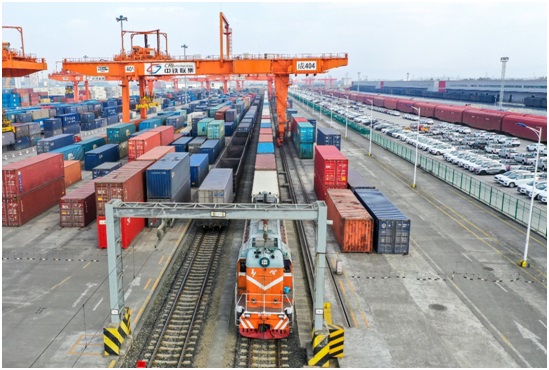By Li Jie, People’s Daily Overseas Edition
China-Europe freight trains secured “hardcore” performance in 2020 despite COVID-19 which laid impacts on industries, especially international logistics。 Further policies and measures will be rolled out soon to promote secure and stable operation of the service.
More than 90 percent of China-Europe freight trains have resumed service, according to statistics released by China’s National Development and Reform Commission (NDRC) on March 8. A total of 1,132 trains had run between China and Europe in the first two months of 2020, six percent more than those from a year ago.
A high proportion of the containers transported were heavily loaded, and departures and returns generally remained in balance. The east, middle and west routes, as well as the land ports of Khorgos, Alashankou, Manzhouli and Erenhot were all in normal operation, with no cargo detained or congestion due to the epidemic.
The resumption of the rail service’s normal operation and stable growth could not have been achieved without the policy support from the country.
On Feb. 24, the General Administration of Customs (GAC) issued 10 measures to facilitate the development of China-Europe cargo train services. It proposed to reduce the frequencies of customs clearance to lower cost, enhance the construction of logistics hubs, and promote joint-transportation services. These measures have largely improved trade facilitation and deepened economic and trade exchanges between China and countries along the China-Europe freight rails.
Besides, the convenience and high mechanization of rail transportation which reduce human contact during the epidemic, as well as the high efficiency of the China-Europe freight service, also contributed to the “hardcore” performance.
The unimpeded logistics is offering strong support for importers and exporters. A train loaded with electronic products, home appliances and clothes produced by enterprises in the Guangdong-Hong Kong-Macao Greater Bay Area departed from Guangzhou, capital of Guangdong province on Feb. 21. It was the first train sent by the Guangdong GW Holdings Group after the Chinese New Year, opening a channel for foreign trade companies to transport their products to Europe and injecting confidence for them to maintain stable operation.
China-Europe freight service embarked on rapid development as China opened wider and implemented the Belt and Road initiative in a more concrete manner over the recent years. Last year, the service reported a 29 percent year-on-year growth to over 8,225 trips between Europe and China, carrying 725,000 standard containers, up 34 percent from a year ago. Ninety-four percent of the containers were heavily loaded. So far, the China-Europe freight trains have made a total of over 21,000 trips, reaching 57 cities in 18 European countries.
While these number are on the rise, the quality of the service is also improving. The time for customs clearance and transportation has been further reduced, and the returning trips are also seeing decreasing empty containers. The value of cargo is also on a growing trend.
China-Europe freight service made positive contribution to stabilizing foreign trade during the special period of epidemic control. Chengdu, capital of southwest China’s Sichuan province, has seen a year-on-year increase of 76.9 percent of the China-Europe freight trains trips since the beginning of the year, and Changsha is also anticipating a 140-percent growth in the first two months of this year. Such performance forcefully guaranteed smooth logistics of foreign trade and its normal operation during the epidemic, contributing to work resumption.
In January and February, China’s biggest specialized shipping company China COSCO Shipping handled 190 million tons of cargos, including 50 million tons of coals and coal products, metallic minerals, oil products, and liquefied natural gas in domestic and foreign trade. The foreign trade of Chinese home appliance giant Haier, Hisense and Midea thrives thanks to the China COSCO Shipping services.
Every week, 20,000-TEU containerships, including COSCO Shipping Aries carrying Chinese electronic products, clothes and furniture would depart from Chinese ports in Shanghai, Ningbo, Qingdao and Tianjin for Piraeus, Antwerp, Rotterdam, Felixstowe, and Hamburg. They have maintained stable operation on the company’s routes to Europe.
Since the onset of the epidemic, the Chinese government kept close cooperation with enterprises on epidemic control and work resumption, ensuring market, logistics and supply stability to safeguard the stable supply chain of the world. As China embraces steady progress of work resumption, Chinese enterprises are getting busy again for global supplies.
A China-Europe freight train loaded with electronic products departs from the Chengdu International Railway Port, starting a 13-day journey to its destination Tilburg, the Netherlands, Feb. 19, 2020. Photo by Bai Guibin, People’s Daily Online










Leave a Comment